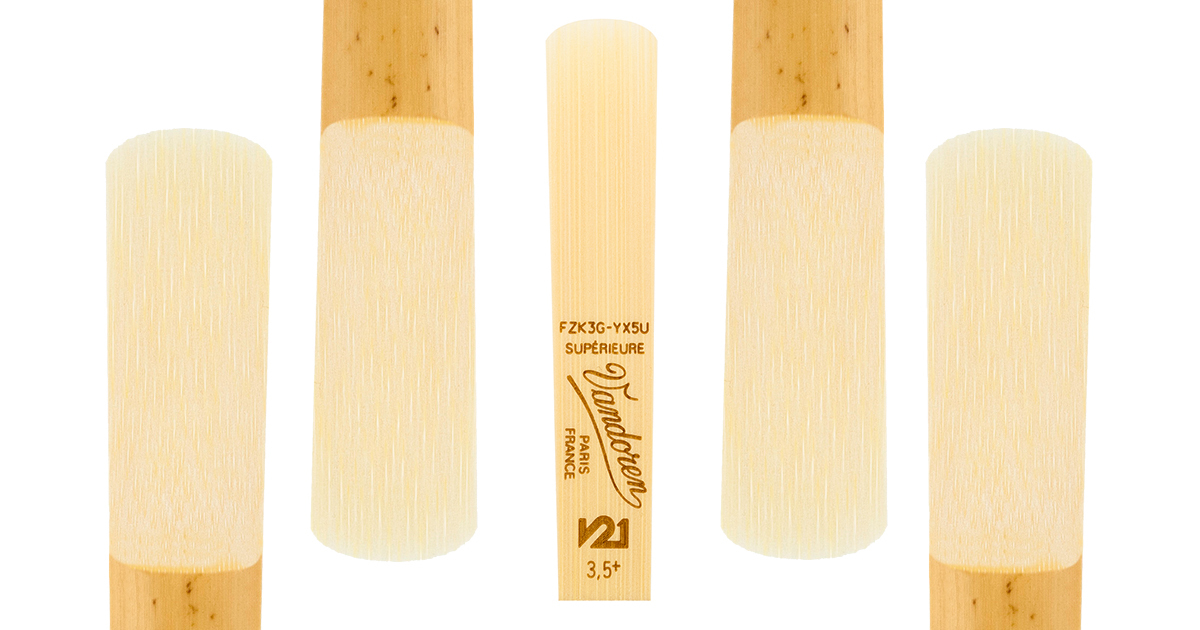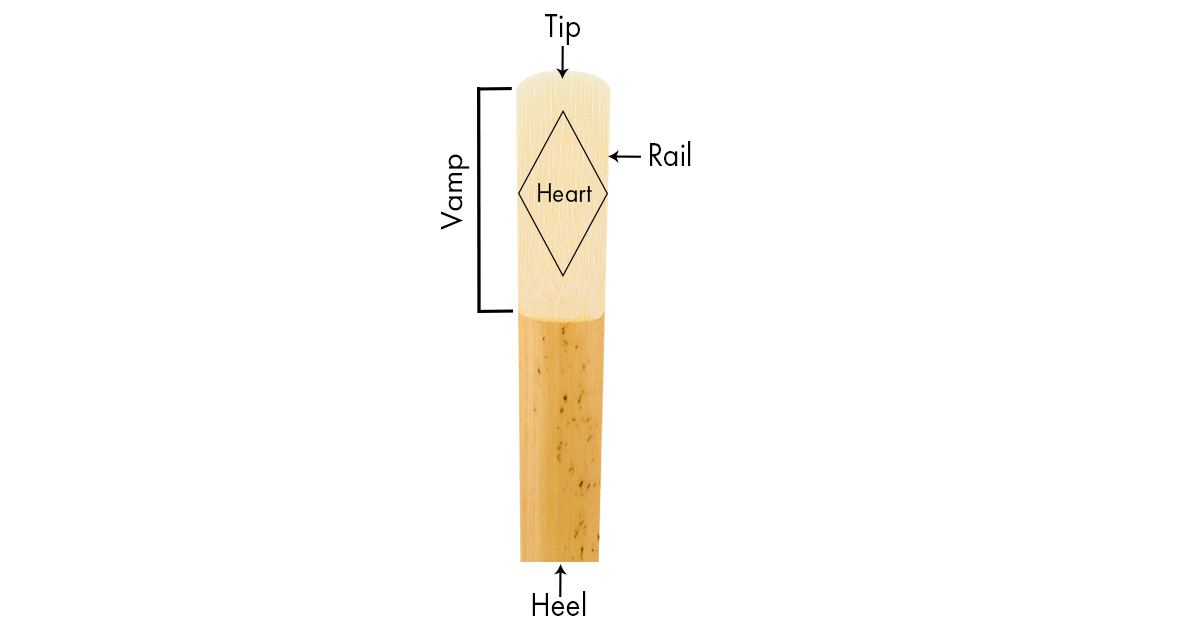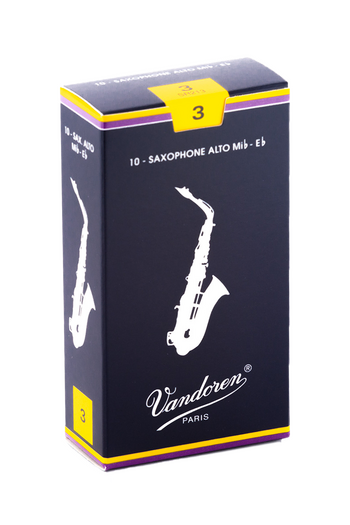Reeds 101 for Band Directors
Date Posted: August 21, 2017

Updated July 27, 2020
Reeds are mysterious things. All those half-steps and different cuts.
How can a band director decide which reed is right for students?
When is it time to move your students up a reed strength?
We hope we can help. Here are some tips that you can pass on to your students to help them navigate through the process of finding the right reed for their mouthpiece.
Reed Anatomy
First, let’s look at how a reed is constructed. While many factors are at play in reed design, as you can see in fig. 1, we’ll focus on just two – the tip and the heart. The relationship between the two can greatly influence a reed's performance. For example, classical reeds feature a relatively thin tip, and a thick heart. The thick heart adds warmth and body to the sound while the thin tip allows for quick crisp articulation and response. Conversely, most jazz reeds feature a thicker tip and thinner heart. This allows more upper overtones to come through giving players the extra color, edge, and possible brighter sound that we’re used to hearing in jazz.

Beyond the actual cut of the reed, the quality of the cane itself is absolutely essential. Inferior cane typically doesn’t last as long and can cause major issues with tone and response. Vandoren cane grows, is harvested, dried, cut, and packaged all in the same region of the world - the Mediterranean Basin. Inferior cane is rejected and used to heat the factory. All of this ensures that Vandoren reeds are made from the highest quality cane.
Reed Troubleshooting
Next, some tell-tale signs that your student might need to change their reed or reed strength:
There is more air than sound
If you are hearing more air than you are sound, it is likely the reed is too hard. To test this, have your student move the reed down below the tip of the mouthpiece. If this improves the sound, the reed strength is too hard. Simply moving down half a reed strength can help to fix this problem.
Inconsistent Intonation
If the student has consistently poor intonation, particularly over the break and you’ve ensured the student’s embouchure is good, try a harder reed. An increase in reed strength will force the student to push more air through the instrument and in turn bring that intonation where you want it to be. If your students are currently playing on JUNO reeds, it may be time to move up to Vandoren Blue Box Traditional reeds. (Refer to Figure 1)
Slow Articulation
When a student has slow articulation, there are adjustments that can be made to fix the problem. You want to be sure that they are using their tongue to articulate at the tip of the reed. As we suggested moving the reed down for less resistance, you could also try moving the reed up a little on the mouthpiece, which makes the reed seem slightly more resistant. If neither of these work, it is time to move up to a harder reed, which can often provide a better launching pad for consistent articulation.
* You can also try moving the reed side to side, as this can improve the response of the reed.
When in doubt, experiment! Move the reed around on the mouthpiece and see what works best for the student.
Reed Suggestions by Ensemble and Student Level

Classical Playing and Concert Band:
For beginners: Vandoren JUNO Reeds
- These are suggested for both clarinet and saxophone.
- These reeds are designed specifically for beginning students.
- They are made from the same cane as all Vandoren reeds, and allow for a quicker response and greater ease of playing throughout all registers.
- They help the student get a full sound more easily, allowing you to teach balance and blend much sooner.
- For more information on JUNO Reeds, please visit www.junoreeds.com

For students at an intermediate-advanced level: Vandoren Traditional
- We suggest these for both clarinet and saxophone.
- These are Vandoren’s most popular reed, and are great for playing all styles of music.
- Traditional reeds give the student a full, even sound with body and depth. If your students have been playing on JUNO Reeds and are ready to move up, our Traditional reeds are the perfect fit.
For more advanced musicians: V12, V21, 56 rue Lepic (clarinet)
- As students progress, they often search for more nuance in their sound, and moving up to these reeds can allow them to reach their full potential.
- V12: The long palette and thicker blank of this reed allows for a richer sound, and the thicker tip gives body to the attack.
- 56 rue Lepic: Featuring a taper similar to German-style reeds, these reeds allow for a centered and colorful sound with exceptional response and stability.
- V21: The V21 reed uses a unique, conically shaped blank design similar to the 56 rue Lepic with a V12 profile, giving your student a warm, focused sound with great presence and immediate response.

For jazz saxophonists:
A good strength for jazz players usually ranges from 2.5 - 3.
Here are our reeds from brightest to darkest:
- Java Green: These reeds will give your student a bright and flexible sound with great presence and projection.
- Java Red: These reeds will provide your student with a full, rich, centered sound with excellent projection.
- ZZ: These reeds will give your student a rich, vibrant sound with great response and durability.
- V16: These reeds will provide your student with a deep and rich tone, with a little more resistance.

These reeds work well for marching band too, as they allow for greater projection. Traditional Blue Box reeds are also a great option for marching band.
Please Note: Jazz reeds typically play a little softer than classical reeds. This helps give players a little more edge and projection in their sound.
Important to Remember
- Reed rotation is important and offers clear performance and health benefits. It is recommended that musicians use at least four different reeds in their rotation. Playing a different reed each time your student picks up their instrument helps to strengthen the embouchure and extend the life of each reed, and prevents excessive germ buildup over time that results from poor reed care.
- Leaving a reed on the mouthpiece after rehearsals can damage the reed, cause warping, and in general is extremely unhealthy. To avoid this, encourage students to wipe excess moisture off their reeds after each use and store their reeds in a quality case. They will last longer, perform better, and the student will stay healthy.
To make pairing mouthpieces and reeds easier, please click on the following links which will direct you to the respective mouthpiece page on the Vandoren website. If you then click to view the product data sheet, you will find helpful charts that recommend reeds and reed strengths for each mouthpiece. For more information, please visit Vandoren.com
Clarinet:
Traditional Bb Clarinet Mouthpieces
Black Diamond Bb Clarinet Mouthpiece
Black Diamond Bass Clarinet Mouthpiece
Saxophone: